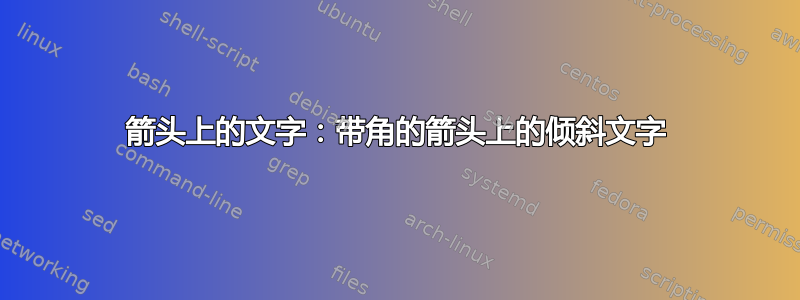
我是新手,正在尝试弄清楚 tikz。
当我有这样的构造时:
\draw [arrow] (node1) node[sloped] {Some text} |- (node2);
我最终得到了如下结果(抱歉,我的 ASCII 艺术格式是这样的...):
|--->
|
Some Text
我如何让“某些文本”垂直,并位于箭头的垂直位置?我一直希望是 [倾斜],但失败了。
为了澄清,因为我显然解释得不好:我希望文本位于垂直线上,只是侧面,也就是说,“文本”确实是倾斜的而不是堆叠的。:
T|--->
e|
x|
t|
答案1
使用选项的替代方案sloped:
\documentclass[tikz, margin=3mm]{standalone}
\begin{document}
\begin{tikzpicture}
\draw [->] (1,1) |- (3,2) node[at start,left,sloped] {Some text};
\end{tikzpicture}
\end{document}
编辑:在您编辑问题之后,您似乎正在寻找其他内容:
\documentclass[tikz, margin=3mm]{standalone}
\begin{document}
\begin{tikzpicture}
\draw [->] (1,1) |- (3,2) node[pos=0.25,above,sloped] {Some text};
\end{tikzpicture}
\end{document}
观察相对位置0.25:它小于0.5表示线上的角。等于或大于的值0.5将文本放在线的水平部分。
如果你有简单的直线,代码就更简单了:
\draw [->] (0,0) -- node[above,sloped] {Some text} (0,2) ;
或等效地
\draw [->] (0,0) -- (0,2) node[midway,above,sloped] {Some text};
其中midway的影响与 相同pos=0.5。两种情况下的结果相同:
有关更多详细信息,请参阅 tikz 和 pgf 手册,第 237 页。
答案2
这里有两种旋转方式(我认为这就是您正在寻找的):
\documentclass[12pt,paper=a4]{scrartcl}
\usepackage{tikz}
\begin{document}
\begin{tikzpicture}
\draw [->] (1,1) node[anchor=east,rotate=90] {Some text} |- (3,2);
\end{tikzpicture}
\begin{tikzpicture}
\draw [->] (1,1) node[yshift=-1cm,rotate=90] {Some text} |- (3,2);
\end{tikzpicture}
\end{document}
输出:
评论:
A)为什么是 90 而不是 -90?
-因为角度是逆时针的
B) 为什么是东边而不是南边?
-因为锚点在旋转90度(逆时针)之前会被调用:
编译下一个示例来查看:
\documentclass[12pt,paper=a4]{beamer}
\usepackage{tikz}
\usepackage{xcolor}
\begin{document}
\begin{frame}
\begin{tikzpicture}
\coordinate (A) at (1,1);
\draw[->] (A)|-(3,2);
\only<1>{\node[opacity=0.3] at (A) {\color{red}Some text};
\node at (-3,0){Without options};
}
\only<2>{\node[opacity=0.6,anchor=east] at (A) {\color{red}Some text};
\node at (-3,0){Anchor=east: called};}
\only <3> {\node[anchor=east,rotate=90,opacity=1] at (A) {\color{red}Some text};
\node at (-3,0){Rotated (around A)};
}
\end{tikzpicture}
\end{frame}
\end{document}
如果您尝试以不同的顺序(相反)解释这些位置,您会发现解释“失败”。
C)yshift 怎么样?
-yshift 是(编辑:几乎总是->例如:@Zarko 的答案中的一个例外是 ax 或 yshift)如果我们不旋转整个 tikzpicture,则始终参考垂直轴
答案3
看来您希望文本沿着以下行:
以下是代码:
\documentclass{article}
\usepackage{tikz}
\begin{document}
\begin{tikzpicture}
\node at (0,0) (nodeA) {A};
\coordinate (nodeB) at (0,2);
\node at (2,2) (nodeC) {C};
\draw[thick,->] (nodeA) -- (nodeB) node [midway, above, sloped] (TextNode) {Text} -- (nodeC);
\end{tikzpicture}
\end{document}
这个sloped论点也适用于有角度的线:
\draw[thick,->] (nodeA) -- (nodeC) node [midway, above, sloped] (TextNode) {Text};
将产生输出:








